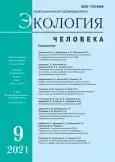CONCENTRATIONS OF PERIPHERAL BLOOD LYMPHOCYTES INTRACELLULAR METABOLIC REGULATORS IN RESIDENTS OF THE EUROPEAN NORTH OF RUSSIA
- 作者: Zubatkina O.V.1, Dobrodeeva L.K.1, Samodova A.V.1, Kruglov S.D.1
-
隶属关系:
- N. Laverov Federal Center for Integrated Arctic Research of the Ural Branch of the Russian Academy of Sciences
- 期: 卷 28, 编号 9 (2021)
- 页面: 43-47
- 栏目: Articles
- URL: https://journals.rcsi.science/1728-0869/article/view/81441
- DOI: https://doi.org/10.33396/1728-0869-2021-9-43-47
- ID: 81441
如何引用文章
全文:
详细
作者简介
O. Zubatkina
N. Laverov Federal Center for Integrated Arctic Research of the Ural Branch of the Russian Academy of Sciences
Email: ozbiochem@gmail.com
доктор биологических наук, профессор, старший научный сотрудник лаборатории экологической иммунологии Института физиологии природных адаптаций Archangelsk, Russia
L. Dobrodeeva
N. Laverov Federal Center for Integrated Arctic Research of the Ural Branch of the Russian Academy of SciencesArchangelsk, Russia
A. Samodova
N. Laverov Federal Center for Integrated Arctic Research of the Ural Branch of the Russian Academy of SciencesArchangelsk, Russia
S. Kruglov
N. Laverov Federal Center for Integrated Arctic Research of the Ural Branch of the Russian Academy of SciencesArchangelsk, Russia
参考
- Almeida L., Lochner M., Berod L., Sparwasser T. Metabolic pathways in T cell activation and lineage differentiation. Semin Immunol. 2016, 28, pp. 514-524.
- Buck M. D., O’Sullivan D., Pearce E. L. T cell metabolism drive immunity. J. Exp. Med. 2015, 212 (9), pp. 1345-1360.
- Chen Z., Li Y., Zhang H., et al. Hypoxiaregulated microRNA-210 modulates mitochondrial function and decreases ISCU and COX10 expression. Oncogene. 2010, 29, pp. 4362-4368.
- Dang E. V, Barbi J., Yang H. Y., et al. Control of T(H)17/T(reg) balance by hypoxia-inducible factor 1. Cell. 2011, 146, pp. 772-784.
- Desdin-Mico G., Soto-Heredero G., Mittelbrunn M., Mitochondrial activity in T cell. Mitochondrion. 2018, 41, pp. 51-57.
- Diebold L., Chandel N. S. Mitochondrial ROS regulation of proliferating cells. Free Radic. Biol. Med. 2016, 100, pp. 86-93.
- Doedens A. L., Phan A. T., Stradner M. H., et al. Hypoxia-inducible factors enhance the effector responses of CD8+ T cells to persistent antigen. Nat Immunol. 2013, 14, pp. 1173-1 182.
- Gaber T., Strehl C., Sawitzki B., et al. Cellular energy metabolism in T lymphocytes. International Reviews of Immunology. 2015, 34, pp. 34-49.
- Giralt A., Villarroya F. SIRT3, a pivotal actor in mitochondrial functions: metabolism, cell death and aging. Biochem. J. 2012, 444, pp. 1-10.
- Kim J. W, Tchernyshyov I., Semenza G. L., Dang C. V. HIF-1-mediated expression of pyruvate dehydrogenase kinase: a metabolic switch required for cellular adaptation to hypoxia. Cell Metab. 2006, 3, pp. 177-185.
- La Gory E. L., Wu C., Taniguchi C. M., et al. Suppression of PGC-1 alpha is critical for reprogramming oxidative metabolism in renal cell carcinoma. Cell Rep. 2015, 12, pp. 116-127.
- Le-Bleu V. S., O’Connell J. T., Gonzalez-Herrera K. N., et al. PGC-1 alpha mediates mitochondrial biogenesis and oxidative phosphorylation in cancer cells to promote metastasis. Nat. Cell Biol. 2014, 16 (10), pp. 992-1003.
- Liesa M., Shirihai O. S., Mitochondrial networking in T cell memory. Cell. 2016, 166, pp. 9-10.
- Lochner M., Berod L., Sparwasser T. Fatty acid metabolism in the regulation of T cell function. Trends Immunol. 2015, 36 (2), pp. 81-91.
- Loftus R. M., Finlay D. K. Immunometabolism: cellular metabolism turns immune regulator. J. Biol. Chem. 2016, 291 (1), pp. 1-10.
- Luo C. T., Li M. O. Transcriptional control of regulatory T cell development and function. Trends Immunol. 2013, 34, pp. 531-539.
- Mylonis I., Sembongi H., Befani C., et al. Hypoxia causes triglyceride accumulation by HIF-1-mediated stimulation of lipin 1 expression. J. Cell Sci. 2012, 125, pp. 3485-3493.
- Palmer C. S., Ostrowski M., Balderson B., et al. Glucose metabolism regulates T cell activation, differentiation, and functions. Front. Immunol. 2015, 6, pp. 1-6.
- Pereira C. V., Lebiedzinska M., Wieckowski M. R., Oliveira P. J. Regulation and protection of mitochondrial physiology by sirtuins. Mitochondrion. 2012, 12, pp. 66-76.
- Pugha C. W., Ratcliffe P. J. New horizons in hypoxia signaling pathways. Exp. Cell Research. 2017, 356, pp. 116121.
- Ren J., Li B. The functional stability of FOXP3 and RORyt in Treg and Th17 and their therapeutic applications. Adv. Protein Chem. Struct. Biol. 2017, 107, pp. 155-189.
- Saravia J., Raynor J. L., Chapman N. M., et al. Signaling networks in immunometabolism. Cell Research. 2020, 30, pp. 328-342.
- Shi L. Z., Wang R., Huang G., et al. HIF-1alpha dependent glycolytic pathway orchestrates a metabolic checkpoint for the differentiation of TH17 and Treg cells. J. Exp. Med. 201 1, 208, pp. 1367-1376.
- Sun R. C., Denko N. C. Hypoxic regulation of glutamine metabolism through HIF1 and SIAH2 supports lipid synthesis that is necessary for tumor growth. Cell Metab. 2014, 19, pp. 285-292.
- Szabo S. J., Kim S. T., Costa G. L., et al. A novel transcription factor, T-bet, directs Th1 lineage commitment. Cell. 2000, 100, pp. 655-669.
- Tao J. H., Barbi J., Pan F. Hypoxia-inducible factors in T lymphocyte differentiation and function. AJP-Cell Physiol. 2015, 309, pp. 580-589.
- Thomas L. W., Ashcroft M. Exploring the molecular interface between hypoxia-inducible factor signalling and mitochondria. Cell Mol. Life Sci. 2019, 76 (9), pp. 1759-1777.
- Ullah M. S., Davies A. J., Halestrap A. P. The plasma membrane lactate transporter MCT4, but not MCT1, is up-regulated by hypoxia through a HIF-1 alpha-dependent mechanism. J. Biol. Chem. 2006, 281, pp. 9030-9037.
- Wise D. R., Ward P. S., Shay J. E., et al. Hypoxia promotes isocitrate dehydrogenase-dependent carboxylation of alpha-ketoglutarate to citrate to support cell growth and viability. Proc. Natl. Acad. Sci. USA. 201 1, 108, pp. 1961119616.
- Zhu J., Yamane H., Paul W. E. Differentiation of effector CD4 T cell populations. Annu Rev. Immunol. 2010, 28, pp. 445-489.
补充文件







